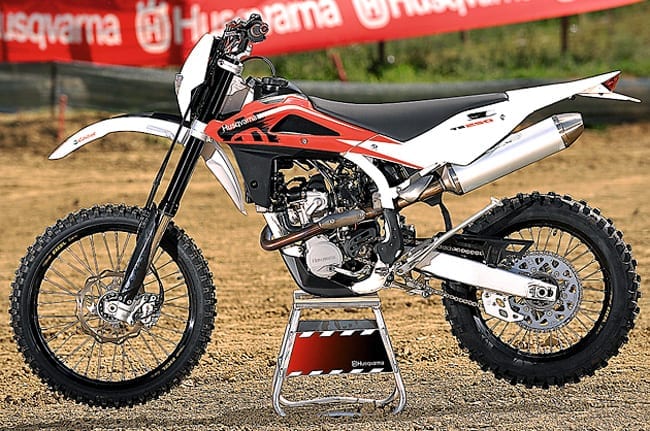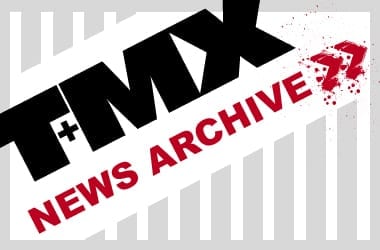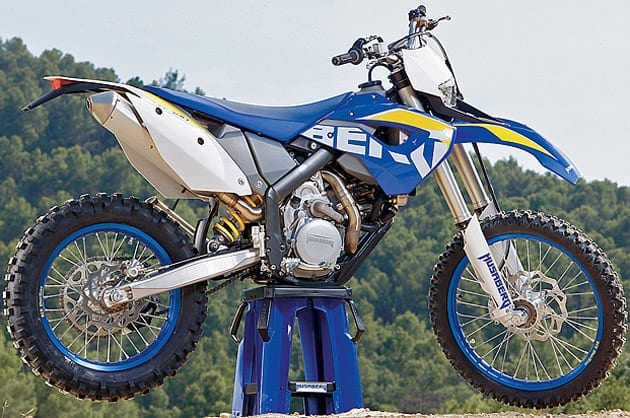Husqvarna TE 250
By TMX Archives on 30th Jul 09

Husqvarna's long-awaited new TE 250 is finally here! A 100 per cent new bike thats smaller, lighter, more powerful, and sexier than the one its replacing, but does it have the performance to match its Italian good looks?
Husqvarna's TE 250 is a bike that has never really received all that much positive press. Although loved by some riders, the majority of the bike buying public have year-on-year opted largely for Orange. And you can't really blame them. While Husky's rivals have long offered specific 250F motors - smaller, more compact, higher-revving and lighter than their 450s - Husqvarna has relied on its 'generic' one-size-fits-all thumper motor.
Truth is Husqvarna's TE 250 is a machine that has been playing catch-up ever since it was born. Developed at a time when Husqvarna was enduring financial troubles, it was essentially a sleeved down version of Husky's TE 450. It was a big, heavy and extremely slow-revving quarter litre four-stroke.
However, that has now changed! Husqvarna's 2010 TE 250 is a completely new bike. New chassis, new suspension, but best of all it features a completely new engine. Developed in the World Enduro Championship over the past three-years, it has now started to show real promise in the hands of Frenchman Antoine Meo.
At the heart of the new TE 250 is a motor that sees the Italian company's smallest displacement enduro offering go from supersize to superskinny. Weighing just 22kg the new power plant is significantly smaller and more compact than the old lump - 13 per cent smaller to be precise. It boasts Mikuni fuel injection, has an electric starter, holds just 900ml of oil, and is 5 per cent lighter than the previous model - that's including the electric starter!
Effectively, it's the new flagship model of the range.
The new engine is built to be a 250F and nothing else! This means that Husqvarna is finally singing from the same hymn sheet as its rivals. The head features four titanium radial valves, which are operated by a DOHC, and is about as different to the old motor in terms of both appearance and design as it could be.
What's exciting about the bike is the fact that the new engine is fitted into a new chassis, which in turn is laced with new for 2010 48mm KYB forks. Gone are the Marzocchi units of old. Sachs still provides the rear shock and Brembo still takes care of the brakes.
Visually, the latest TE 250 is stunning - sleek, angular, and in places quite minimalist, the lines of the bike are sporty and dynamic. In fact there's not really any area of the bike that doesn't look good. The build quality of the bike is solid, and should be better than ever thanks to the appointment of a new chassis supplier.
With its black wheel rims, black inner engine casings and black sump guard the bike appears bottom heavy and even when static seems well planted. The white plastics and frame make the top half of the bike look light. Together they combine to give the TE 250 a fresh, crisp look.
The bike's detail and finishing is hard to fault. There's no uncomfortable routing of any cables or hoses and all body panels fit perfectly. The headlight design is questionably a little 'old school' but the upward sweeping rear fender and flat seat give the bike a very modern appearance. From a machine that was anything but sleek and slender the TE 250 now leads the way in terms of clean, lightweight looking small bore four-stroke enduro bikes.
With the fuel tank designed to offer plenty of space and easy access to the spark plug/rocker cover area, the bike does carry a little extra width, due to the wider fuel tank. Certainly not fat feeling, it's just a little wider than some other bikes but forgotten about as soon as the wheels start turning.
The bars feel notably raised from the triple clamps, which gives a great deal of knee room. Everything that should fit within the chassis does and the position of all controls feels natural.
With the TE 250 the only completely new model in Husqvarna's 2010 range, interest at the world launch in Italy was understandable high. But with a limited number of test models on offer, time on the sexy new machine was limited.
There were a number of things that instantly made an impression during the first ride, some good, some not so. I'll deal with the not so good first. Although firing into life instantly via the button when collected from the Husky technicians, the bike developed an electric starter fault. From being able to use just the button, it then needed an assist with a prod of the kick starter. Then after ten to 15-minutes the only way the bike would start was by using the right leg.
I'm going to give Husky the benefit of the doubt here and say that for whatever reason they must have had a problem with the recharging of the bike's battery. I can't believe it would be anything more serious, and if it was, I'm sure it'll be fixed by the time the bikes are shipped to all four corners of the world. Not a great first impression however.
The second thing that raised a question mark or two was the blubbery bottom-end. With a Mikuni fuel injection system fitted the injection throughout the rev range shouldn't have been a problem, but it was. Again it might just have been a setting used on the day, but if it was it didn't work well at all. Cracking the throttle while the bike was stationary resulted in an initially lumpy power delivery and it wasn't until the bike reached about 2,000 rpm did it become crisp. Once crisp however it remained that way right through to the top-end.
Winding the motor up a little so as to lift the revs to around lower mid-range resulted in the bike running sweet as a nut. Let the revs drop however and the bike couldn't be made to pull higher gears at all. Had the bike been fitted with a carb, I'd have said the jetting was way off. As it's fitted with a fuel injection unit I'm not sure what the problem was.
It wasn't so much just a lethargic, gentle bottom-end power delivery, the bike simply refused to run cleanly down low, which obviously curtailed its ability to be ridden lazily at low rpm.
That's the negatives out of the way. Injection and starting issues aside, I loved the TE 250.
What the new TE 250 motor does have is a great mid-range. A little like the 2009 motor, if you over rev it, the power drops off quite quickly but from around 2,000 rpm upwards the engine is responsive, strong and puts its power to the ground well. It helps to ride it more like a 125 than a bigger bike, but when kept singing the general motor performance was right where it needed to be.
Gone, thankfully, is the 'wind it up before you need it' power of old.
The new motor delivers great, tractable power, and although it can't be laboured too heavily - it is a 250F after all - it can, once into the mid-range be ridden with just the throttle. Without having to think you can point the bike at a climb and then, if needed, knock it down a cog, rather than needing to be in the correct gear first, as was the case with the bike it supercedes.
A small difference, but a big, big difference.
Riders stepping onto the TE 250 from a motocross bike that's been converted for enduro use will notice the bike doesn't respond too well to being over revved. Once revved right out, the bike needs to be up-shifted to keep the engine pumping out its power. This lack of over rev was only a problem when pushing the bike hard around the flat turns of the mock Italian special test.
Track manners were hard to fault. The new 48mm KYB forks are night and day better than the Marzocchi units they replace and arguably every bit as good, if not better, than the WP units used by KTM and Husaberg.
Where forks set for general enduro use tend to be a little soft when it comes to dealing with rougher terrain ridden at speed, the KYB units dealt equally well with all manor of different situations. They aided the bike in tracking well across smaller, choppy bumps, dived nicely to aid flat corner turning, and didn't disappoint when asked to soak up the ride when crossing rougher going. And all with a 100kg rider on board! The forks also seemed to respond well to clicker changes, which the Marzocchis didn't always do.
The small, compact feel meant that it always felt, well, small and compact, no matter whether how tight a corner. Moving around on top of the TE 250 was effortless thanks to the open cockpit, getting the bike to change direction was incredibly easy, and flicking the bike left and right at speed was also a joy. With the possible exception that smaller riders might not feel quite as comfortable on the TE 250 as they might like, the bike's handling was hard to fault.
Although changed little from previous models the Brembo brakes fitted to the TE 250 at the international launch in Italy seemed exceptionally strong. With a good feel, slowing the bike down was never a problem. In addition the action of the hydraulic clutch was also faultless.
Starting and low-end injection issues aside, the bike is now of worthy consideration for anyone looking for a new 250F enduro mount.
As light and agile on track is it is stylish and skinny to look at, the motor's mid-range performance is impressive. Happiest when kept in its mid-range the bike offers a much more complete and competitive ride than in years past.
The X-Light is coming - Husky's TC 250 ready for action
Although released to the world's press earlier this year as a 2009 model, Husqvarna 'X-Light' TC 250 has so far only been available in limited numbers to specialist teams and dedicated Husqvarna customers.
However now the bike, which according to Husqvarna has seen significant modifications, is available to the general public.
The bike itself is changed radically to that unveiled earlier in the year, and does feature a 15mm shorter swing arm, to improve traction, as well as getting closed cartridge 48mm KYB forks, new wheel hubs and spindles. The light-weight 22kg motor has had a little extra power squeezed out of it as well as getting a little more torque.
State of play - Looking forward with optimism
Make no mistakes about it - these are tough times for bike manufacturers. Be they Japanese or European, the reduction in the numbers of units being sold around the world has hit all companies hard.
However, Husqvarna is optimistic about the coming years.
"No manufacturer is enjoying the tough economic times we face at the moment, but we are optimistic that things will improve and that our market share will grow," explained Martino Bianchi, Husqvarna's PR and Racing Activities coordinator.
"We are continuing to push forward with our racing activities and plan to maintain a high presence in many different off-road disciplines, especially in the World Enduro Championship. We have enjoyed a great season so far with our riders doing well in all classes and on both two and four-stroke machines."
Numerous new Husqvarna employees were introduced at the official unveiling of the new TE 250 and TC 250, proving that Husqvarna is serious about pushing forward despite the economic downturn. "Things are really moving forward," added Bianchi.
What's new for 2010 - Facts 'n' figures at a glance
WR 125
IPD (In Plastic Design) Graphics, plastics, rear mudguard with integrated number plate, rear light cluster, exhaust pipe, silencer, reinforced frame, Sachs rear shock absorber
WR 250
IPD Graphics, plastics, KYB 48mm forks, Fork clamps, exhaust system
WR 300
IPD Graphics, plastics, KYB 48mm forks, exhaust system
TE 250
IPD Graphics, plastics, KYB 48mm forks, fork clamps, front headlight, rear mudguard with integrated number plate, rear light cluster, reinforced frame, shortened rear swing arm
TE 310
IPD Graphics, plastics, front headlight, rear mudguard with integrated number plate, rear light cluster, reinforced frame, shortened rear swing arm, radiator connectors and hoses, water pump
TE 450
IPD Graphics, plastics, KYB 48mm forks, fork clamps, front headlight, rear mudguard with integrated number plate, rear light cluster, reinforced frame, shortened rear swing arm, radiator connectors and hoses, water pump
TE 510
IPD Graphics, plastics, KYB 48mm forks, fork clamps, front headlight, rear mudguard with integrated number plate, rear light cluster, reinforced frame, shortened rear swing arm, radiator connectors and hoses, water pump
Specification:
ENGINE
Type: Single cylinder, water cooled, DOHC four-stroke, with electric starter
Bore and Stroke: 79 x 50.9 mm
Capacity: 249.5cc
Fuel System: Electronic fuel injection, Mikuni D42
CHASSIS
Frame: Steel single tube cradle, with aluminium sub-frame
Forks: KYB 48mm, USD
Shock: Sachs, double compression adjustment
BRAKES
Front: Brembo, 260 mm rotor
Rear: Brembo, 240 mm rotor
DIMENSIONS
Wheelbase: 1,470 mm
Length: 2,260 mm
Seat Height: 950 mm
Ground Clearance: 290 mm
Dry Weight (no fuel): 106 kg
Fuel capacity: 7 litres

